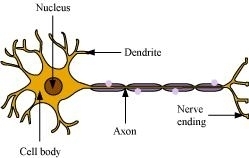NCERT Solution: Control and Coordination
The brain is responsible for
(a) thinking.
(b) regulating the heart beat.
(c) balancing the body.
(d) all of the above.
Answer :
(d) The brain is responsible for thinking, regulating the heart beat and balancing the body.
Receptors are sensory structures (organs/tissues or cells) present all over the body. The receptors are either grouped in case of eye or ear, or scattered in case of skin.
Functions of receptors:
(i) They sense the external stimuli such as heat or pain.
(ii) They also trigger an impulse in the sensory neuron which sends message to the spinal cord.
When the receptors are damaged, the external stimuli transferring signals to the brain are not felt. For example, in the case of damaged receptors, if we accidentally touch any hot object, then our hands might get burnt as damaged receptors cannot perceive the external stimuli of heat and pain.
Neurons are the functional units of the nervous system. The three main parts of a neuron are axon, dendrite, and cell body.

Structure of a neuron
Functions of the three parts of a neuron:
Axon: It conducts messages away from the cell body.
Dendrite: It receives information from axon of another cell and conducts the messages towards the cell body.
Cell body: It contains nucleus, mitochondria, and other organelles. It is mainly concerned with the maintenance and growth.
The growth movement in plants in response to light stimulus is known as phototropism.The shoots show positive phototropism and the roots show negative phototropism. This means that the shoots bend towards the source of light whereas the roots bend away from the light source.
Some examples of phototropism are as follows:
(a) The flower head of sunflower is positively phototropic and hence it moves from east to west along with the sun.
(b) The ovary stalk of groundnut is positively phototropic before fertilization and becomes negatively phototropic after fertilization, so that the fruit is formed underground.
The reflex arc connections between the input and output nerves meet in a bundle in the spinal cord. In fact, nerves from all over the body meet in a bundle in the spinal cord on their way to the brain. In case of any injury to the spinal cord, the signals coming from the nerves as well as the signals coming to the receptors will be disrupted.
In animals, control and coordination occur with the help of nervous system. However, plants do not have a nervous system.
Plants respond to stimuli by showing movements. The growth, development, and responses to the environment in plants is controlled and coordinated by a special class of chemical substances known as hormones. These hormones are produced in one part of the plant body and are translocated to other needy parts. For example, a hormone produced in roots is translocated to other parts when required. The five major types of phytohormone are auxins, gibberellins, cytokinins, abscisic acid, and ethylene. These phytohormones are either growth promoters (such as auxins, gibberellins, cytokinins, and ethylene) or growth inhibitors such as abscisic acid.
The maintenance of the body functions in response to changes in the body by working together of various integrated body systems is known as coordination. All the movements that occur in response to stimuli are carefully coordinated and controlled. In animals, the control and coordination movements are provided by nervous and muscular systems. The nervous system sends messages to and away from the brain. The spinal cord plays an important role in the relay of messages. In the absence of this system of control and coordination, our body will not be able to function properly. For example, when we accidentally touch a hot utensil, we immediately withdraw our hand. In the absence of nerve transmission, we will not withdraw our hand and may get burnt.
Involuntary actions cannot be consciously controlled. For example, we cannot consciously control the movement of food in the alimentary canal. These actions are however directly under the control of the brain. On the other hand, the reflex actions such as closing of eyes immediately when bright light is focused show sudden response and do not involve any thinking. This means that unlike involuntary actions, the reflex actions are not under the control of brain.